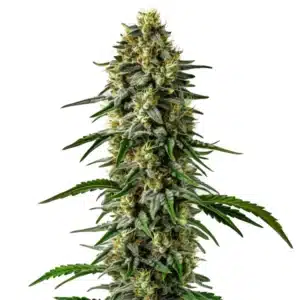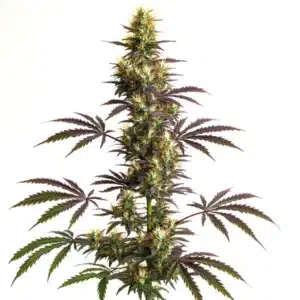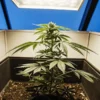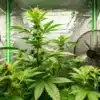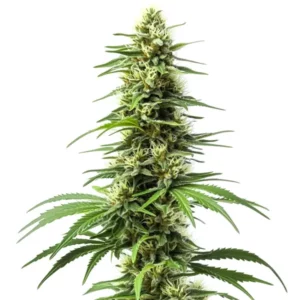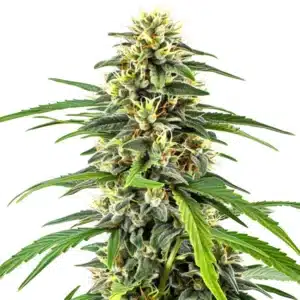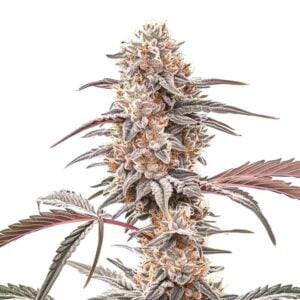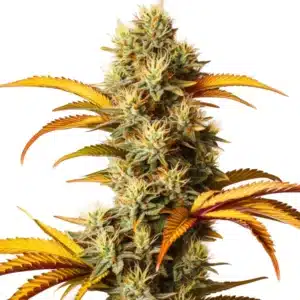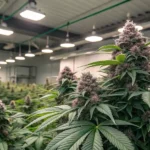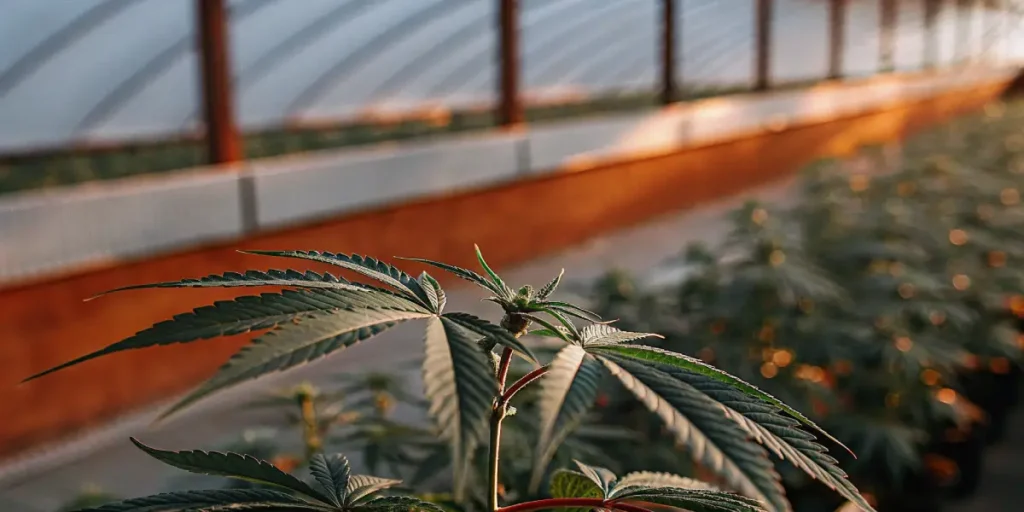
Phytochrome System in Cannabis Explained
The phytochrome system in cannabis is a fascinating and essential part of the plant’s life cycle. It’s a light-sensing mechanism that helps cannabis plants determine the time of day and even the time of year. This system is crucial for regulating the plant’s growth and flowering. By comprehending how the phytochrome system works, both first-time cannabis seed buyers and seasoned growers can optimize their cultivation methods.
Cannabis plants rely on the phytochrome system to transition between vegetative growth and flowering. This system includes two types of phytochromes: phytochrome red and phytochrome far-red. These light-sensitive proteins change states based on the light spectrum they absorb. During the day, the plant absorbs more red light, while at night, far-red light becomes more influential.
Recommended Strains
Blue Dream
|
|
THC | 17% - 24% (Medium) |
|
|
Type | Feminized |
|
|
Yield | High |
|
|
Phenotype | 50% Indica / 50% Sativa |
GG4
|
|
THC | 27% (High) |
|
|
Type | Feminized |
|
|
Yield | High |
|
|
Phenotype | 40% Indica / 60% Sativa |
To illustrate, consider the cannabis strain Blue Dream from Blimburn Seeds. This popular strain has specific light requirements that, when met, can enhance its yield and potency. By aligning the light schedule to the phytochrome response, growers can ensure that Blue Dream and other strains thrive in their environment.
How the Phytochrome System Affects Cannabis Growth
The phytochrome system in cannabis cultivation is vital for managing the plant’s growth phases. It helps the plant detect changes in daylight, triggering essential growth responses. These responses include the transition from vegetative growth to flowering, which is crucial for maximizing yield.
Phytochrome impact on cannabis growth cycle is profound. For instance, when the days shorten, the phytochrome system signals the plant to begin flowering. This is especially important for strains like Gorilla Glue #4, known for its high yield and potency. By knowing this system, growers can manipulate light conditions to trigger flowering at the optimal time.
Knowing how the phytochrome system influences cannabis plant development allows growers to tailor their approach to each growth phase. The transition from vegetative to flowering stages is particularly pivotal, as it directly impacts the plant’s ability to produce buds. By leveraging the phytochrome system in cannabis cultivation, growers ensure plants receive the correct signals for each stage.
The cannabis phytochrome role in flowering is especially critical during late summer when natural light begins to wane. Growers who understand the phytochrome system can use this period to their advantage, ensuring their plants flower at the right time for maximum yield. This strategic use of the phytochrome system can significantly enhance overall plant productivity and quality.
Practical Applications for Growers
Growers can use the phytochrome system to their advantage. By adjusting light exposure, they can influence the timing of the plant’s flowering phase. For example, changing the light schedule to include more darkness can prompt the plant to flower sooner. This technique is useful for indoor growers who want to control the growth cycle.
Another practical example is using the phytochrome response to reduce energy costs. By knowing cannabis phytochrome response, growers can optimize their light schedules. They can provide just enough light to trigger the desired growth phase without wasting energy.
Incorporating the phytochrome system in cannabis cultivation practices allows for a more controlled approach to plant development. By carefully monitoring and adjusting light exposure, growers can fine-tune flowering times, ensuring that plants mature at the desired pace. This method is particularly beneficial for those managing multiple strains with varying light requirements.
Moreover, the cannabis plant phytochrome system explained in detail can help cultivators address specific challenges related to environmental conditions. By manipulating light exposure, growers can create conditions that mitigate stress factors such as temperature fluctuations, ultimately promoting healthier and more robust plants.
Promos & Deals
Manipulating Light for Optimal Growth
Adjusting light exposure is a straightforward method to influence cannabis growth. By mimicking natural light cycles, growers can ensure their plants receive the right signals. This method is particularly effective in controlled environments like indoor grow rooms or greenhouses.
Using artificial lights, growers can replicate the sun’s natural spectrum. This involves using different types of bulbs to provide both red and far-red light. By carefully controlling the light spectrum, they can manipulate the cannabis phytochrome role in flowering, ensuring the plant transitions smoothly between growth phases.
Effective manipulation of light not only supports seamless transitions between growth stages but also enhances plant resilience to environmental stressors. By knowing the phytochrome system in cannabis explained, growers can implement strategies that bolster plant vitality, leading to healthier crops with superior yields.
Additionally, by strategically scheduling light exposure, growers can maximize their cultivation space. This approach allows for staggered planting and harvesting cycles, ensuring a continuous supply of mature plants ready for market. Such efficiency is particularly advantageous for commercial operations seeking to optimize output.
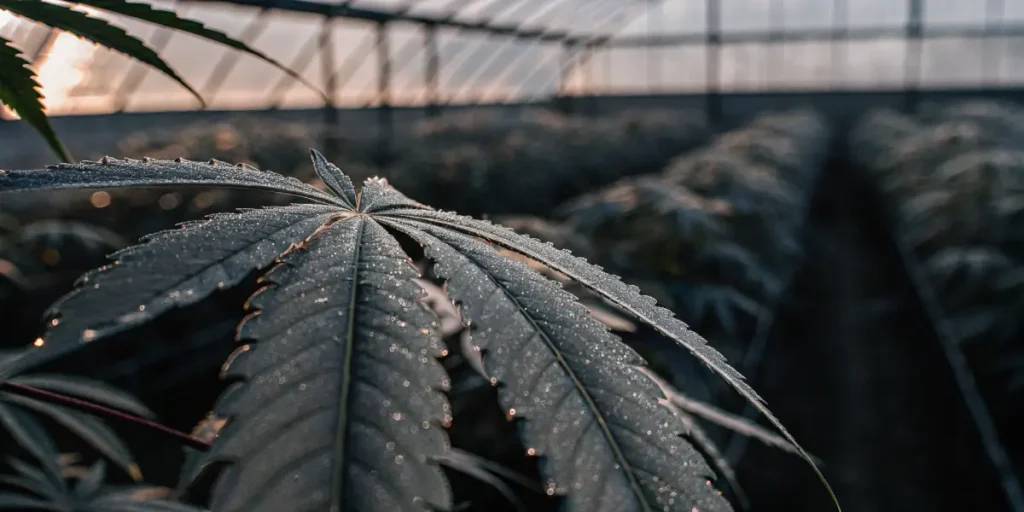
Benefits of Controlled Light Schedules
Controlled light schedules offer several advantages. They allow for year-round cultivation, as growers are not limited by outdoor conditions. This flexibility is beneficial for maintaining consistent crop quality and yield, regardless of the season.
Growers can also reduce the risk of pests and diseases by controlling the environment. A stable light schedule helps maintain healthy plants, which are more resistant to common issues. Additionally, a well-managed light cycle can improve the overall efficiency of the cultivation process.
Consistent and controlled light exposure ensures that plants receive the optimal amount of energy necessary for robust growth. This precision in light management helps prevent issues such as light burn or insufficient light, which can adversely affect the plant’s health and productivity.
Furthermore, knowing the interplay between light and the phytochrome system in cannabis cultivation empowers growers to create a more sustainable operation. By minimizing excess light usage, growers contribute to energy conservation efforts while simultaneously reducing operational costs.
FAQs: Phytochrome System in Cannabis
What is the phytochrome system in cannabis?
The phytochrome system in cannabis is a group of light-sensitive proteins that help the plant perceive changes in light. This system regulates key processes such as germination, flowering, and growth. By responding to different light wavelengths, the phytochrome system helps the plant adapt to its environment.
For growers, knowing the phytochrome system is crucial for successful cannabis cultivation. By manipulating light conditions, they can control the plant’s growth cycle. This knowledge allows them to optimize their growing environment and achieve better yields.
The function of the phytochrome system extends beyond simple light detection; it acts as a sophisticated mechanism that informs the plant’s biological clock. Knowing cannabis phytochrome response provides insights into the plant’s internal timing mechanisms, which are essential for strategic planning in cultivation practices.
By demystifying the cannabis plant phytochrome system explained through research and practice, growers can effectively synchronize cultivation schedules with natural plant rhythms. This alignment enhances the overall growth experience, resulting in healthier plants and more abundant harvests.
How does the phytochrome system affect flowering?
The phytochrome system plays a significant role in the flowering process of cannabis. It helps the plant determine the right time to flower based on the length of day and night. When days are shorter, the plant receives signals to start flowering, a process critical for strains like Gorilla Glue #4.
By controlling light exposure, growers can influence the timing of flowering. This is particularly useful for indoor cultivation, where light conditions can be precisely managed. Properly timing the flowering phase can lead to healthier plants and higher yields.
The ability to manipulate the cannabis phytochrome role in flowering allows growers to extend or shorten the flowering period as needed. This control is particularly advantageous for commercial operations aiming to meet specific market demands or scheduling constraints.
Furthermore, the phytochrome impact on cannabis growth cycle ensures that plants receive the necessary signals for transitioning into the flowering stage, promoting optimal bud development and enhancing overall plant vigor. This knowing is key to achieving high-quality cannabis products.
Can the phytochrome system be manipulated for better growth?
Yes, growers can manipulate the phytochrome system to enhance cannabis growth. By adjusting light schedules, they can control when the plant enters different growth phases. This manipulation is essential for indoor growers aiming to maximize their harvest.
For instance, using a combination of red and far-red light can influence the plant’s growth cycle. By providing the right light at the right time, growers can ensure their plants receive optimal signals for growth and flowering.
The strategic manipulation of the phytochrome system in cannabis cultivation involves tailoring light exposure to suit specific growth objectives. This targeted approach enables growers to optimize plant development, from seedling to harvest, ensuring each phase is executed with precision.
By knowing the nuances of the phytochrome system, cultivators can implement advanced techniques such as light deprivation or supplementation, further enhancing plant performance and yield potential. This comprehensive understanding is invaluable for both novice and experienced growers.
What are the benefits of knowing the phytochrome system?
Knowing the phytochrome system offers several benefits for cannabis growers. It allows for precise control over the growth cycle, leading to improved plant health and yield. By syncing the light schedule with the plant’s natural responses, growers can optimize their cultivation practices.
This knowledge also helps reduce waste and energy costs. By providing the right amount of light, growers can avoid overexposure and ensure efficient use of resources. This is particularly beneficial for large-scale operations looking to improve sustainability.
Comprehensive knowledge of the phytochrome system in cannabis explained provides growers with the tools needed to address and mitigate common cultivation challenges. This knowing fosters an environment where plants can thrive, leading to increased productivity and reduced instances of crop failure.
Additionally, mastery of the phytochrome system empowers growers to make informed decisions about light technologies and schedules, enhancing the overall efficacy of their cultivation efforts. This expertise ultimately contributes to the production of premium cannabis products.
How can beginners start using the phytochrome system?
Beginners can start using the phytochrome system by choosing strains that are forgiving and adaptable, such as Amnesia Haze. This strain is known for its resilience and can help new growers learn the ropes of light manipulation.
Starting with a reliable lighting setup is also crucial. Beginners should invest in quality lights that offer a full spectrum, allowing them to experiment with different light cycles. Over time, with practice and observation, they can fine-tune their approach to achieve optimal results.
For those new to the concept, seeking guidance from experienced growers or resources that explain the phytochrome system in cannabis cultivation can provide valuable insights. Learning from those with practical experience helps shorten the learning curve and improve cultivation outcomes.
Embracing a trial-and-error approach allows beginners to gain firsthand experience with the cannabis phytochrome role in flowering and growth. By continuously observing and adjusting light strategies, novice growers can develop a deep knowing of the system’s impact on plant development.




